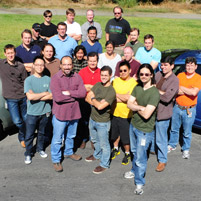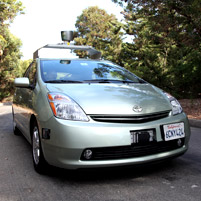Driven to Innovate


"Too hard." That, recalls Chris Urmson, was the consensus in the robotics community back in 2003, when the Pentagon announced a robot race that would cover more than 100 miles in 10 hours.
But by 2005, five robotic vehicles — including two from Carnegie Mellon — completed a 132-mile race over Nevada desert in the Defense Advanced Research Project's Grand Challenge. And two years later, Carnegie Mellon's robotic SUV, Boss, won DARPA's followup race, the $2 million Urban Challenge.
As a graduate student and then a faculty member of Carnegie Mellon's Robotics Institute, Urmson played key roles on the groundbreaking "Challenge" teams led by William "Red" Whittaker, director of the Field Robotics Center.
Now, on leave from the institute, Urmson again has contributed to a milestone for self-driving vehicles as a member of Google Inc.'s autonomous vehicle project. Its eight cars have logged more than 1,000 miles on public roads with no human intervention and more than 140,000 miles with only the slightest human help, an unprecedented achievement.
"The work we're doing out here is very exciting," Urmson said. It's an achievement he shares with a large Carnegie Mellon contingent on the roughly 15-member Google team.
Eight members have current or past ties to CMU, a pioneer in autonomous navigation. They include James Kuffner, an adjunct faculty member in the Robotics Institute; Don Burnette, a PhD robotics student on leave; Matthew McNaughton, a Google intern who has returned to finish his PhD in robotics; Nathaniel Fairfield and Michael Montemerlo, who earned PhDs in robotics in 2009 and 2003, respectively, and Philip Nemec, a 1995 computer science graduate. Sebastian Thrun, a former associate professor at Carnegie Mellon now at Stanford University, heads up Google's robot car project.
The project has taken advantage of expertise from the DARPA challenges. "The Urban Challenge, at the time, was definitely the state of the art," Urmson explained. Tartan Racing's Boss and the other vehicles travelled more than 50 miles over urban-style roads, obeying traffic laws and safely sharing the road with human-driven and robotic vehicles. "They were the most capable vehicles around."Google's eight vehicles- seven Toyota Priuses and an Audi TT — use many of the same kinds of sensors that Boss did - a revolving laser radar, or LIDAR, sensor atop the car to provide a 360-degree view, automotive radars, a GPS receiver and inertial motion sensors.
"We certainly haven't closed our eyes to what has come before," Urmson said, "but the technology has evolved tremendously." A video camera and new software, for instance, now enable the cars to detect traffic signals and see pedestrians.
Numerous autonomous navigation projects proceed at Carnegie Mellon, including collaborative research with General Motors on autonomous driving.
Urmson said it's too soon to say how the Google autonomous driving technology might make it's way into the marketplace — whether as a fully robotic car, as an accident avoidance system or in some other form. But he knows he wants to have a hand in it.
"This work," he said, "is my passion."
Related Links: School of Computer Science on Twitter | More on mobile robotics | Google blog post
